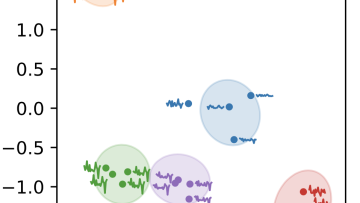12:00
Weak continuity of isometric embeddings and interaction with fluid dynamics / Finite-time degeneration for Teichmüller harmonic map flow
Abstract
The second fundamental form of an embedded manifold must satisfy a set of constraint equations known as the Gauß-Codazzi equations. Since work of Chen-Slemrod-Wang, these equations are known to satisfy a particular div-curl structure: under suitable L^p bound on the second fundamental form, the curvatures are weakly continuous. In this talk we explore generalisations of this original result under weaker assumptions. We show how techniques from fluid dynamics can yield interesting insight into the weak continuity properties of isometric embeddings.
/
Teichmüller harmonic map flow is a geometric flow designed to evolve combinations of maps and metrics on a surface into minimal surfaces in a Riemannian manifold. I will introduce the flow and describe known existence results, and discuss recent joint work with M. Rupflin that demonstrates how singularities can develop in the metric component in finite time.
12:00
Regularity for minimisers of the Total Variation Flow in metric measure spaces
Abstract
In this talk I will discuss some aspects of the potential theory, fine properties and boundary behaviour of the solutions to the Total Variation Flow. Instead of the classical Euclidean setting, we intend to work mostly in the general setting of metric measure spaces. During the past two decades, a theory of Sobolev functions and BV functions has been developed in this abstract setting. A central motivation for developing such a theory has been the desire to unify the assumptions and methods employed in various specific spaces, such as weighted Euclidean spaces, Riemannian manifolds, Heisenberg groups, graphs, etc.
The total variation flow can be understood as a process diminishing the total variation using the gradient descent method. This idea can be reformulated using parabolic minimizers, and it gives rise to a definition of variational solutions. The advantages of the approach using a minimization formulation include much better convergence and stability properties. This is a very essential advantage as the solutions naturally lie only in the space of BV functions. Our main goal is to give a necessary and sufficient condition for continuity at a given point for proper solutions to the total variation flow in metric spaces. This is joint work with Vito Buffa and Juha Kinnunen.
Cohomogeneity one families in Spin(7)-geometry
Abstract
An 8-dimensional Riemannian manifold with holonomy group contained in Spin(7) is Ricci-flat, but not Kahler. The condition that the holonomy reduces to Spin(7) is equivalent to a complicated system of non-linear PDEs. In the non-compact setting, symmetries can be used to reduce this complexity. In the case of cohomogeneity one manifolds, i.e. where a generic orbit has codimension one, the non-linear PDE system
reduces to a nonlinear ODE system. I will discuss recent progress in the construction of 1-parameter families of complete cohomogeneity one Spin(7) holonomy metrics. All examples are asymptotically conical (AC) or asymptotically locally conical (ALC).
Networks provide powerful tools and methods to understand inter-connected systems. What is the most central element in a system? How does its structure affect a linear or non-linear dynamical system, for instance synchronisation? Is it possible to find groups of elements that play the same role or are densely connected with each other? These are the types of questions that can be answered within the realm of network science. For standard algorithms to be used, however, it is usually expected that the underlying network structure is known.
In 2018, the World Health Organization added “Disease X” to its list of priority diseases, alongside diseases like Ebola virus disease and SARS. Disease X is representative of infectious agents that are not currently known to cause cases in humans. In other words, it denotes the possibility of an epidemic of a disease that we have never seen before.
Hydrodynamic limit for a facilitated exclusion process
Abstract
During this talk we will be interested in a one-dimensional exclusion process subject to strong kinetic constraints, which belongs to the class of cooperative kinetically constrained lattice gases. More precisely, its stochastic short range interaction exhibits a continuous phase transition to an absorbing state at a critical value of the particle density. We will see that the macroscopic behavior of this microscopic dynamics, under periodic boundary conditions and diffusive time scaling, is ruled by a non-linear PDE belonging to free boundary problems (or Stefan problems). One of the ingredients is to show that the system typically reaches an ergodic component in subdiffusive time.
Based on joint works with O. Blondel, C. Erignoux and M. Sasada
Infinite limit of (fully connected) neural networks: Gaussian processes and kernel methods.
Abstract
In practice, it is standard to initialize Artificial Neural Networks (ANN) with random parameters. We will see that this allows to describe, in the functional space, the limit of the evolution of (fully connected) ANN when their width tends towards infinity. Within this limit, an ANN is initially a Gaussian process and follows, during learning, a gradient descent convoluted by a kernel called the Neural Tangent Kernel.
This description allows a better understanding of the convergence properties of neural networks, of how they generalize to examples during learning and has
practical implications on the training of wide ANNs.
Unitary, Symplectic, and Orthogonal Moments of Moments
Abstract
The study of random matrix moments of moments has connections to number theory, combinatorics, and log-correlated fields. Our results give the leading order of these functions for integer moment parameters by exploiting connections with Gelfand-Tsetlin patterns and counts of lattice points in convex sets. This is joint work with Jon Keating and Theo Assiotis.



